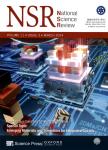Direct observation and manipulation of hot electrons at room temperature
Direct observation and manipulation of hot electrons at room temperature作者机构:State Key Laboratory of Infrared Physics Shanghai Institute of Technical Physics Chinese Academy of Sciences University of Chinese Academy of Sciences Henan Key Laboratory of Diamond Optoelectronic Materials and Devices School of Physics and Engineering Zhengzhou University School of Microelectronics Shandong University Department of Physics Lancaster University Department of Electronic Materials Engineering Research School of Physics and Engineering The Australian National University
出 版 物:《National Science Review》 (国家科学评论(英文版))
年 卷 期:2021年第8卷第9期
页 面:32-40页
核心收录:
学科分类:080901[工学-物理电子学] 0809[工学-电子科学与技术(可授工学、理学学位)] 08[工学]
基 金:supported by the National Key R&D Program of China (2017YFA0305500) Royal Society-Newton Advanced Fellowship (NA170214) National Natural Science Foundation of China (61725505 and 11991063) Shanghai Science and Technology Committee (19XD1404100, 18JC1420401,2019SHZDZX01 and 20ZR1474000) Youth Innovation Promotion Association,CAS Strategic Priority Research Program of Chinese Academy of Sciences (XDB43010200)
主 题:hot electrons valley transfer photogating scanning photocurrent mapping
摘 要:In modern electronics and optoelectronics, hot electron behaviors are highly concerned, as they determine the performance limit of a device or system, like the associated thermal or power constraint of chips and the Shockley-Queisser limit for solar cell efficiency. To date, however, the manipulation of hot electrons has been mostly based on conceptual interpretations rather than a direct observation. The problem arises from a fundamental fact that energy-differential electrons are mixed up in real-space, making it hard to distinguish them from each other by standard measurements. Here we demonstrate a distinct approach to artificially(spatially) separate hot electrons from cold ones in semiconductor nanowire transistors, which thus offers a unique opportunity to observe and modulate electron occupied state, energy, mobility and even path. Such a process is accomplished through the scanning-photocurrent-microscopy measurements by activating the intervalley-scattering events and 1D charge-neutrality rule. Findings here may provide a new degree of freedom in manipulating non-equilibrium electrons for both electronic and optoelectronic applications.



